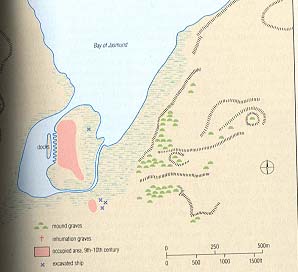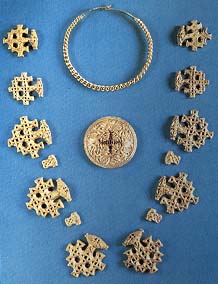


Rügen is a small island located at 54o31' North Latitude and 13o30' East Longitude, across the southern shores of Sweden in the Baltic Sea. The island was part of Pomerania in eastern Germany.
Some think Rügen island might have been the home of the Greek temple of Apollo, in 500 B.C. Apollo was the god of light and the sun-god who loved amber and amber was thus considered sacred. The largest deposits of amber, in the world, and those exploited the longest, were on the shores of the Baltic Sea in northern Europe. Baltic amber has a rich history of ancient trade, supported by guilds of amber craftsmen and stunning works of art. Apollo's love of music, poetry and all the fine arts, made him the perfect god for the craftsmen on the island.
The best amber is found near the eastern Baltic sea on the Samland Peninsula. This area produced 90 percent of all the amber in Europe. Amber has been harvested for at least ten millenia (Grimaldi, David A. Amber: Window to the Past. New York: Harry N. Abrams, Inc., 1966.).

The island of Rügen was founded by Swedish Vikings, and was an easy reach from their settlement of Hedeby (Johnson, Kenneth. Slavic Sorcery:Shamanic Journey of Initiation. St Paul, MN.: Lyewellyn Publications, 1998, 14). Rügen was a political center and trading outlet of the Rugieris, a powerful Slavic tribe, also called Rugii, and they were found on the coast of Pomerania. Its sheltered harbor, called Ralwick, was on the trade route from Gotland (another Baltic Island).
Archaeological discoveries, at Arkona and Ralswich, show that there was a great trading center, fortress, and large pagan temple on Rügen island (Graham-Campbell, James, Colleen Batey, Helen Clarke, R.I. Page, and Neil Price. Cultural Atlas of the Viking World. New York: Facts on File, 1994, 184.). Other Western Slavs were the Obotrites, Wiltze, Wolins, and Pomerians. They all maintained a large number of coastal settlements that were of great importance in the Baltic trading sphere. Scandinavian merchants were also permanently settled in some of these market centers.
Excavations show two main settlements on Rügen:
The Golden Hoard from Hiddensee, from Denmark (late 10th century) was found among the artifacts on the island of Rügen The cuniform pendants and filigree spacers were thought to be joined together as one necklace. Other artifacts were 22,790 coins from the 9th century Arabic and Asian cultures.
The Balts were a seafaring, piratical people. Goths came from Gautland (southern Sweden) and Gotland Island. The Visigoths under Götrijk, landed on Rügen and on the Pomeranian mainland.
Danish historian, Saxo Grammaticus wrote, about 1200, that there was a great idol of the Prussian god, Svantovit, in the interior of the temple and it was draped with purple robes and sacrificial treasure. The four-headed Statue of Svantovit (showing his four aspects) was nearly thirty feet in height. Mutiple heads were a feature of the Slavs' pantheon. It was thought that Svantovit may have been worshipped as a supreme diety and was seen as a father to the other gods (much like the Greek god Zeus). Food and drink were offered to Svantovit, including a special honey cake the size of a man. Excavations show that animals were also sacrificed here, and humans. Human sacrifice was a widespread custom throughout the Germanic and Slavic lands, and people were sacrificed to Svantovit before any great undertaking.
In the High Middle Ages, Svantovit/Svantetit was revered by the Balts and Slavs alike. This island was also sacred to the god, Rugeviet (his name means "master on Rugen"), whose sacred rowan trees grew there in abundance. Rugeviet was the Slavic god of war. He was represented with seven heads and usually holds a sword in his hand. At Karentia (Garz) at the southern end of Rügen, there was a shrine containing multi-headed images of the gods Porevit/Porenutius (a four-headed god-each head faced one of the four cardinal directions) and Rugevit/Rugeviet. Svantovit was a Slavic war and vegetation god who was worshipped on the island of Rügen. He was the chief of the islanders and protector of their fields. In the temple of Svantovit there was a horn (cornucopia) of precious metal that was filled with wine annually (in the spring), as an oracle. At this time, the whole nation assembled at the harvest festival, and the high priest decided whether the nation should go to war or not. The high priest was the only Wendish man allowed to grow his hair long. The High Priest was given his own estates and all the bullion taken in war; in addition, he had his own army of three hundred cavalry. Prior to the Danish destruction of the temple, legend tells of Svantovit riding a Great White Horse, while warring against Rugieris' enemies. Their booty was dedicated at the wooden temple. It was also believed that Svantovit would ride at night against those who denied his divinity. In the morning, his horse was often discovered to be covered in sweat. Omens for success in war were read from the behavior of the sacred horse (Cotterell, Arthur. Norse Mythology: The Myths and Legends of Nordic Gods. New York: Smithmark Publishers (The Mythology Library Series), 1997, 61). This temple was said to resemble another Slavic cult site at Gross-Raden on mainland Germany.

|
The Horse: "St John, "the Beloved," had envisioned Jesus Christ riding on a magnificent horse: Behold a white horse: and he that sat on him had a bow; a crown was given to him: and he went forth conquering, and to conquer" . - Revelations 6:2
Good guys on white horses have come to represent "justice, honor, and the American Way" (Pavia, Audrey
Famous white horses:
----Marengo - owned by Napoleon |
In the temple on Rugen Island, the images of the dieties were considered so sacred that only the priests were allowed to see them. Sacred objects included: a holy saddle and bridle of Svanovit, used on the sacred white horse during ceremonies. Another major cult object was Svantovit's sword! The sacred white horse was kept in the Temenos at Arcona.
It is also legendary that Rugen Island had both black and white dwarfs.
The Pomeranians converted to Christianity in 1128, under the influence of the missionary Bishop Otto of Bamberg. The upper classes, in Pomerania, were persuaded by the advantage of a culture shared with their trading partners. An active pagan faction continued among the poorer classes, and temples on Rügen were active until 1168 or 1169, even after the death of Duke Nyklot in 1160.
The Duke of Rügen's daughter, Lucia of Rugia, married (in 1195) Wladyslaw Laskonogi (116--1231). Wlayslaw was the son of Mieszko III Stary and Eudoxia of Kiev. Mieszko died in 1202. Lucia's father was Iaromar/Jaromar, Duke of Rügen. The Dukes of Rügen were a cadet branch of the Princes of the Obotrities, a Slavinic tribe on the nearby mainland.
Later Boleslaw Wrymouth would conquer eastern Pomerania (in 1294), but many traditions would continue. Peasants drank mead rather than ale, while nobles drank mare's milk mixed with blood (Johnson, 14).
Christmas Eve was called the Kuchiya or special feast (and special food was eaten on these special days). Kuchiya was usually composed of barley groats, poppy seeds, and honey. After supper, everyone rose except the master of the house. He hid behind the pot of Kuchiya and asked whether his wife could see him.
The wife always replied, "Yes."
Then the husband would say: "I hope that you might not see me next year."
This was to insure a good harvest for the following year. Next year, it was hoped, the harvest would be so great that father would be invisible when he stood behind it.
Hay was placed under the Kuchiya and the tablecloth. Later, the hay would be given to the animals. The fire was kept burning and not much work was done on that day. The above ceremony had its origin on the island of Rügen.
***note that this custom, of putting hay under the tablecloth, is the same as is practiced at Wigilia, a Polish Christmas Eve ceremonial dinner.
The priest of the god Svantovit hid behind the piled harvest, which had been gathered in the temple, thus playing the role of a family's father, while the people of Rügen assembled and played the role of the wife. The questions and answers were always the same, as was the custom. The purpose of the ritual being for better harvests in the future. Many ceremonies were held in the sacred groves of rowan trees.
We only have a small amount of information about the areas of Viking activities in the Baltic area, because the Slavs and Balts were basically illiterate, and the Viking runic alphabets were only good for short inscriptions (Haywood, John. The Penguin Historical Atlas of the Vikings. New York/London: Penguin Books, 1995). The Wends had a large number of trading towns along the southern Baltic coast, and finds of Arabic silver coins show they were tied to the Baltic and Russian trade routes. The Wends had a reputation for being warlike.
German pirates were prevalent later in the Baltic and North Seas. A famous German pirate, named Klaus Stortebeker , was a Hanseatic Pirate of the North Sea, in 1392. This former merchant formed a pirate band called the 'The Friends of God and Enemies of the World'. They sailed the Baltic sea and attacked the city of Bergen, in Norway. Klaus Stortebeker was the Robin Hood of the region. Several villages, in Ostfriesland, East Frisia, claim to be his birthplace. he was executed in 1402.
Today Rügen island has the towns of Sassnitz and Bergen (see first map), and in 1993, the ashes of a Polish freedom fighter and his wife were reinterred in their native village and two young birch trees, sacred trees in Baltic paganism were planted by the grave.
Ten kilometers from Sassnitz railway station is a resort: "an 85 hectare spacious, beautiful nature resort on the island of Ruegen/Rugen. Adhacent to the National Part, Jasmund, with its chalk cliffs." (at Steigenberger MAXX Resort Rügen).
RELATED LINKS:
[Slavic Paganism| Okana's Slavic/Polish Pages| Amber |Andzia's Amber: Imports From Poland|Berno(Info. on the Wends)|Rugen/Ruegen as a resort
